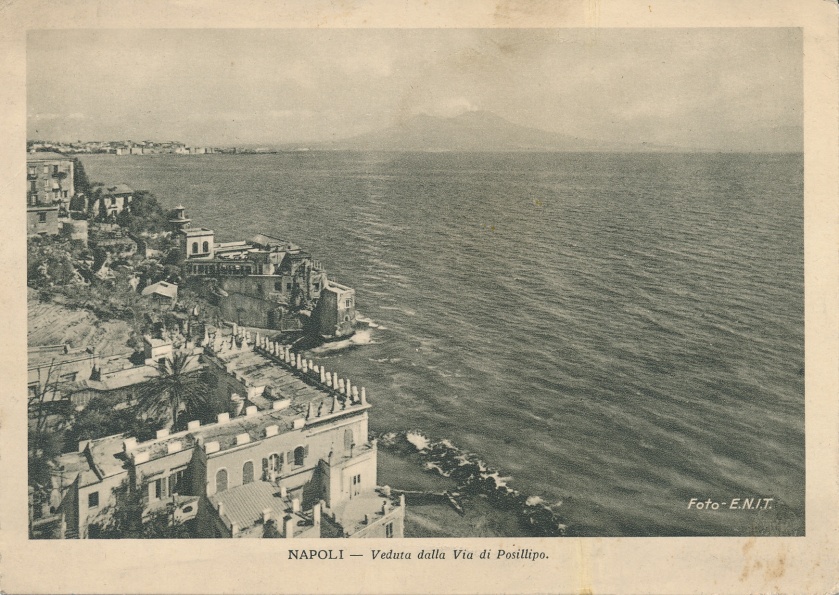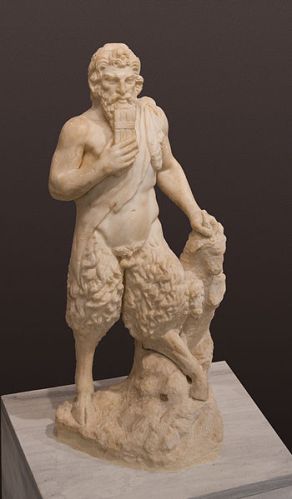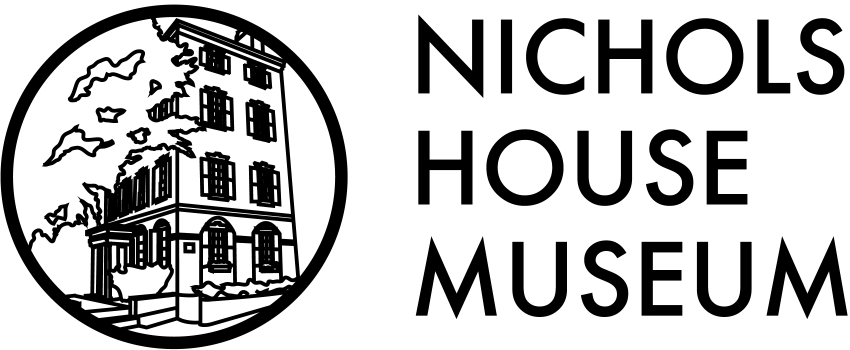The Nichols family’s love of travel is well documented through letters, diaries, postcards, and photographs. Rose Nichols visited Europe more than thirty times to visit friends, see museum collections, attend conferences, and study gardens for her many articles and books about European landscape architecture. Evidence of the family’s many tours through Europe is found throughout the house in the form of paintings, furniture, textiles, and other souvenirs.

One piece in particular stands out as a fascinating example of the renewed interest in ancient Roman furnishing styles during the 19th century. This bronze oil lamp features a crane that is perched on a budding oak tree surrounded by a wreath of acanthus leaves. The tree emerges from a stand held up by three animal legs with cloven hooves and a small lizard meandering along the base. The crane holds a wire form in its beak that holds two small vessels on chains along with a pair of tweezers. These small vessels would have provided the lamp’s light. They would have been filled with olive oil, which was used as the lamp’s fuel source. Wicks would be inserted into the vessels using the lamp’s tweezers [1]. As this lamp was manufactured in Italy in the late 19th century, it was most likely never used in the traditional fashion as a light source.

In During the eighteenth and nineteenth centuries, archaeological discoveries at Pompeii and Herculaneum caused a renewed interest in ancient Roman art throughout Europe and the United States, and reproductions of ancient artifacts became common [2]. Rose Nichols was aware of this trend in her home decor, as well as her garden scholarship and design. In her 1928 book Italian Pleasure Gardens she writes:
“For centuries Herculaneum and Pompeii lay smothered under masses of lava and ashes. Finally in 1748, skillful archaeologists began to remove this heavy mantle and discovered a wealth of artistic treasures buried in the buildings and gardens. These works are now scattered in various museums all over the world, but many of the finest objects have been claimed by the National Museum at Naples. Here we can study a superb collection of bronze and marble statuary, wall paintings, mosaics, furniture and household utensils. Even the humblest articles often show the hand of a skilled designer.” [3]

Etruria, an ancient civilization that spanned the geography north of the city of Rome from roughly 500-700 BC, was also a source of inspiration for eighteenth and nineteenth century designers [4]. This piece employs the characteristics of an ancient Etruscan lantern, including the traditional round hanging lamps and its tripod base, but this object’s strong relationship to ancient Roman and Etruscan history is also found in its symbolic representation of animals.
The main figure featured in this lamp is the crane. The crane is rich with symbolism in the ancient world. The crane represented seasonal change, as the migration patterns were well observed by early Greeks and Romans [5]. The crane’s circular style of movement or “dance” was associated by the ancients with the seasonal movement of the sun [6]. The relationship to the changing of the seasons and the cycle of the sun’s movement have a clear connection to light, making the crane an appropriate figure to be holding up the oil vessels that provided the lamp’s glow.

The base is supported by three animal legs with cloven hooves. Three-legged lamp stands with hooves seemed to be common in Etruria, as examples of these footed lamps are found in museum collections in the British Museum, the Museum of Fine Arts, and the Metropolitan Museum of Art. The three hooves seen on this lamp appear to be representative of the feet of goats: ancient Greek and Roman mythology included the god Pan, who represented the power of nature and was fabled to be able to control the weather by playing his flute [8]. As images of Pan often showed a man with the horns and legs of a goat, the isolated goat legs of this lamp could be a reference to Pan and his connection to the natural world.

The lizard crawling across the lamp’s base is a very small feature that is difficult to notice on first glance. But its symbolism throughout Etruscan and Roman history is fascinating in reference to the function of this object. The ancient Romans saw lizards as a symbol of death and rebirth, due to a belief that the animals hibernated in the winter months and reappeared in the spring. In Etruscan tradition, people also believed that lizards went blind as they aged but could regain their sight by bathing in bright sunlight [9]. This belief caused lizards to become symbolic of light and heat, making them a perfect image to adorn an oil lamp.

This small bronze oil lamp is representative of ancient Roman and Etruscan civilization and the resurgence of their decorative tradition in the 19th century. The three animal seen on this small oil lamp – the crane, goat, and lizard – suggest the ancient understanding of light. Through referencing daily cycles of the sun, the shifting of the seasons, or by the changing of the weather, the animals that decorate this bronze lamp all give meaning to the lamp’s traditional function: to illuminate dark spaces.
[1]Haines, T. L. Museum of Antiquity; a Description of Ancient Life. By L. W. Yaggy. Chicago: Western House, 1884. 287-95.
[2]Wilton-Ely, John. “Pompeian and Etruscan Tastes in the Neo-Classical Country-House Interior.” Studies in the History of Art 25 (1989): 51.
[3]Nichols, Rose Standish. “Pompeian Peristyles.” Italian Pleasure Gardens. New York: Dodd, Mead, 1931. 5.
[4]Wilton-Ely, John. “Pompeian and Etruscan Tastes in the Neo-Classical Country-House Interior.” Studies in the History of Art 25 (1989): 51.
[5]Johnsgard, Paul A., “Cranes of the World: 8. Cranes in Myth and Legent” (1983). Cranes of the World, by Paul Johnsgard. Paper 11. 70.
[6]Ibid. 73.
[7]Fox, William Sherwood. The Mythology of All Races: Greek and Roman. Vol. 1. Boston: Marshall Jones, 1916. 268.
[8]Leland, Charles Godfrey. Etruscan Roman Remains in Popular Tradition. London: T. F. Unwin, 1892. 267-68.
By Emma Welty, Curatorial and Administrative Specialist



You must be logged in to post a comment.